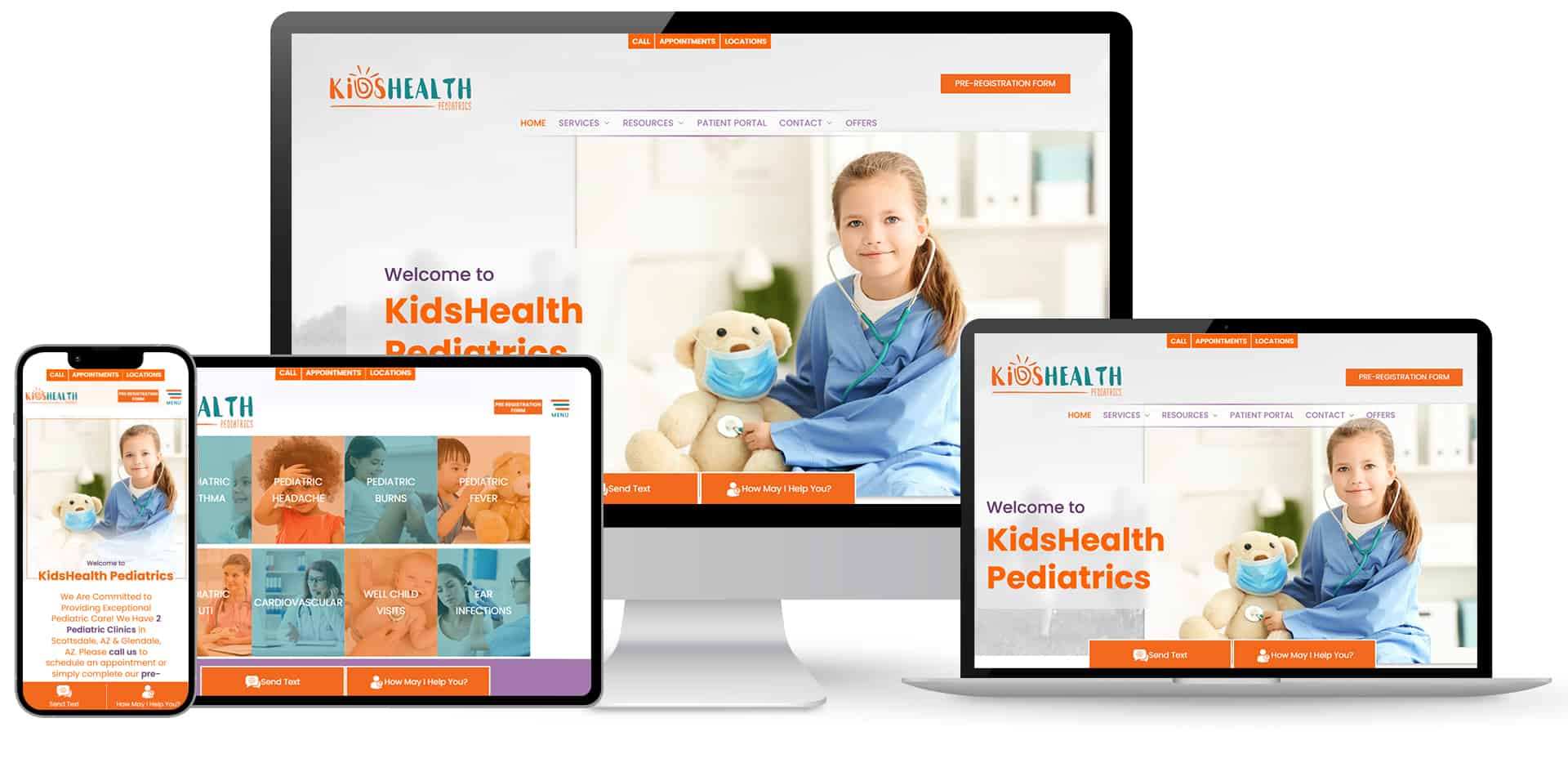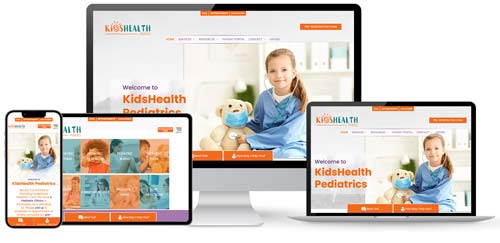Digital Marketing For Pediatricians & Pediatric Clinics
Pediatric Marketing Cost $799/mon to $999/mon. Medical Marketing For Pediatricians Simplified. Includes Website and Facebook Marketing, and SEO Services Plus Email Marketing
Most of the 62,000+ Pediatric Clinics in the US were started to attain optimal physical, mental, and social health for all infants, children, adolescents and young adults. Running a practice and a profitable business to achieve this goal comes with additional responsibilities and challenges. Let’s face it, as a medical practice owner, it becomes difficult to learn technology and run your business at the same time, it is time consuming and takes you away from your core focus of taking care of your patients and running your medical practice. Medical Marketing for your practice does not have to be difficult.


Key Considerations for Pediatric Practices – Included in the PatientGain Services:
- HIPAA Compliance: This is non-negotiable. All digital marketing activities must safeguard patient privacy. Any vendors (like marketing agencies) with access to PHI must sign a Business Associate Agreement (BAA).
- Building Trust: Parents are making decisions about their children’s health. Every online interaction must build trust, showcase expertise, and convey a caring environment.
- Parent-Centric Approach: All content and messaging should be tailored to address the needs, concerns, and questions of parents and guardians.
- Showcasing a Child-Friendly Atmosphere: Use visuals and language that appeal to both parents and children, highlighting a welcoming and non-intimidating environment.
- Consistency: A consistent online presence across all channels reinforces the brand and message.
- Tracking and Adapting: Using analytics to understand what’s working and refining strategies accordingly.
Key Steps For Your Marketing:
- Building a Welcoming and Informative Online “Front Door” (Your Website):
- Child-Friendly, Parent-Focused Design:
- Example: Instead of stark corporate blues, use a color palette of soft greens, yellows, and light blues. Imagery might include diverse children engaged in play, gentle interactions between pediatricians and young patients (with photo consent), or illustrations of friendly animals. Avoid overly clinical or scary medical imagery.
- Essential Information, Easily Accessible:
- Services Offered: “Well-Child Visits (Newborn to 18 Years),” “Same-Day Sick Child Appointments,” “School & Sports Physicals,” “Immunization Schedules & Catch-Up,” “Developmental Screening (Ages & Stages Questionnaires),” “Asthma & Allergy Management,” “Newborn Care & Lactation Support.”
- Meet the Pediatricians/Staff: Dr. Emily Carter’s bio might highlight her 10 years of experience, her special interest in childhood asthma, her own experience as a mother of two, and a quote like, “My goal is to partner with parents to help every child thrive.”
- New Patient Information: A clearly labeled “New Patients” tab with downloadable PDF forms like “New Patient Registration Form,” “Medical History Form,” and “HIPAA Notice of Privacy Practices.”
- Appointment Booking: A prominent “Request an Appointment” button that links to an online form or clearly lists the phone number with a call-to-action like “Call Us to Schedule Your Visit!”
- Mobile-Responsiveness:
- Example: A parent on their smartphone should be able to easily tap a phone number to call the clinic directly from the website or find the address with a one-tap link to Google Maps without excessive pinching or zooming. Menus should be simplified for mobile (e.g., a “hamburger” menu).
- HIPAA Compliance:
- Example: An online appointment request form might include a disclaimer like, “Please do not include sensitive medical details in this form. A member of our team will contact you to discuss your child’s needs securely. This form is submitted over a secure, encrypted connection.”
- Child-Friendly, Parent-Focused Design:
- Getting Found Online (Search Engine Optimization – SEO):
- Local SEO is Key:
- Google Business Profile (GBP): Under “Services,” list “Well-child checkups,” “Vaccinations,” “Flu shots,” “ADHD management,” etc. A Google Post example: “Flu season is here! We have flu shots available for all ages. Click ‘Book’ to schedule your child’s appointment or call us at [Phone Number]. #FluShot #Pediatrics #[YourCityName]”
- Local Keywords: “after hours pediatrician [YourCity],” “newborn doctor [YourZipCode],” “autism screening [YourTown] pediatric clinic,” “children’s flu vaccine [YourCity].”
- Online Directories: On Healthgrades, ensure all listed services are accurate and that links to your website and appointment booking are correct.
- Content-Driven SEO:
- Example Pages Titles: “Is My Child’s Fever Too High? A Parent’s Guide by [Your Clinic Name],” “Navigating Picky Eaters: Tips from a [YourCity] Pediatrician,” “When to Schedule Your Baby’s First Dental Visit (and Why It Matters).”
- Local SEO is Key:
- Providing Value and Building Trust Through Content Marketing:
- Educational Blog Posts:
- Infants: “Sleep Training Methods: What Works?” “Introducing Solids: A Step-by-Step Guide.”
- Toddlers: “Potty Training Without Tears,” “Managing Temper Tantrums: Advice for Parents.”
- School-Age: “Bullying: How Parents Can Help,” “Homework Strategies for Kids with ADHD.”
- Teens: “Talking to Your Teen About Vaping,” “Mental Health Resources for Adolescents in [Your Area].”
- FAQs: “What immunizations does my child need at their 2-month check-up?” “How do I transfer my child’s medical records to your practice?” “What should I do if my child gets sick after hours?”
- Video Content: A 1-minute video of Dr. Smith explaining the importance of the HPV vaccine, a short animated video showing what happens during a well-child visit to ease anxiety for young children.
- Downloadable Resources: “Printable Immunization Tracker,” “Emergency Contact Information Sheet for Babysitters,” “Ages & Stages Developmental Milestones Checklist (0-5 Years).”
- Educational Blog Posts:
- Engaging with the Community (Social Media Marketing):
- Platform Choice: Facebook for sharing articles, practice updates, and engaging with local parent groups (by having parents share your content there). Instagram for sharing appealing visuals, quick tips, and behind-the-scenes (staff-focused) content.
- Content Strategy:
- Facebook Post Example: “It’s National Reading Month! 📚 Reading to your child from a young age boosts brain development and creates wonderful memories. What’s your child’s favorite book right now? Share in the comments! #Pediatrics #EarlyLiteracy #[YourPracticeName]”
- Instagram Post Example: A colorful graphic with “Tip Tuesday: Ensure your child gets 60 minutes of active play each day! 🏃♀️⚽️ #HealthyKids #[YourCityPediatrician]” or a photo of the friendly staff decorating the clinic for a holiday (with their consent).
- Tone: “We’re here for you and your little ones!” “Your child’s health is our top priority.” “Let’s navigate these parenting adventures together.”
- HIPAA Compliance:
- Safe Post: “We’re seeing a lot of seasonal allergies this spring! Remember to keep windows closed during high pollen counts and talk to us about management options. #AllergySeason”
- Unsafe Post (AVOID): “So glad little Johnny is feeling better after his asthma attack last week! Great to see him smiling today.” (This shares PHI without consent).
- Managing Your Online Reputation:
- Encouraging Reviews: At the end of a positive visit, a staff member might say, “We’re so glad we could help today! If you had a good experience, we’d be grateful if you shared your feedback on Google. It helps other parents find us.”
- Monitoring Reviews: Setting up Google Alerts for your practice name or using reputation management software.
- Responding Professionally:
- Positive Review Response: “Thank you so much for your kind words, [Reviewer Name]! We’re thrilled to hear you had a positive experience with Dr. Lee and our team. We look forward to seeing you again!”
- Negative Review Response: “Dear [Reviewer Name], thank you for your feedback. We are sorry to hear that your experience did not meet your expectations. We take patient satisfaction very seriously. Please contact our practice manager, [Manager Name], at [Phone Number] or [Email Address] so we can discuss your concerns directly and privately. [Your Practice Name].”
- Targeted Outreach (Paid Advertising – PPC):
- Google Ads:
- Ad Group: Same-Day Sick Visits
- Headline 1: Sick Kid? See a Pediatrician Today
- Headline 2: [Your Clinic Name] – [Your City]
- Headline 3: Fast Appointments for Children
- Description: Caring pediatric care for coughs, colds, fevers & more. Easy online booking. Compassionate doctors.
- Ad Group: Same-Day Sick Visits
- Social Media Ads (Facebook/Instagram):
- Targeting: Parents with children aged 0-5 in a 10-mile radius of your clinic who have shown interest in parenting or child health pages.
- Ad Concept: A short video ad showcasing your welcoming clinic environment and a friendly pediatrician, with text overlay: “New Pediatric Practice in [Your Neighborhood]! Accepting New Patients. Click to Learn More & Schedule a Meet & Greet.”
- Focus (Calls to Action): “Book Your Child’s Check-Up Now,” “Find a Pediatrician Near You,” “Get Same-Day Care.”
- Google Ads:
- Staying Connected (Email Marketing – With Consent):
- Newsletters:
- Content Ideas: “Dr. Anya’s Corner: Tips for a Healthy Summer Break,” “Spotlight on: Understanding the Meningitis B Vaccine,” “Upcoming Community Health Fair – Visit Our Booth!” “Recipe: Kid-Friendly Healthy Smoothies.”
- Segmentation:
- Segment: Parents of newborns (0-6 months).
- Tailored Content: Emails with links to blog posts like “Your Baby’s First Foods” or “Safe Sleep for Infants.”
- Segment: Parents of teenagers.
- Tailored Content: Information about sports physicals, mental health resources for teens, or HPV vaccine reminders.
- Newsletters:
Key Considerations with Examples:
- HIPAA Compliance:
- Scenario to Avoid: A staff member uses their personal email (not a secure clinic email) to send appointment reminders that include the child’s full name and reason for visit.
- Good Practice: Using a HIPAA-compliant email marketing platform and ensuring all staff are trained on not sharing PHI through unsecured channels.
- Building Trust:
- Website Element: A clear “Our Philosophy of Care” page that outlines the practice’s commitment to patient-centered, evidence-based, and compassionate medicine.
- Parent-Centric Approach:
- Language Choice: Instead of overly clinical jargon like “cephalic hematoma,” use “a bruise on the baby’s head that is common after birth and usually resolves on its own.”
- Child-Friendly Atmosphere (Online):
- Visual: A “Kids’ Corner” section on the website with links to age-appropriate health games or coloring pages (hosted on external, trusted sites).
- Consistency:
- Branding: Using the same clinic logo, color scheme, and font style across the website, social media profiles, email newsletters, and even printed materials.
- Tracking and Adapting:
- Metric to Track: “Number of new patient appointment requests originating from our Google Business Profile listing this month” or “Click-through rate on our Facebook ad promoting well-child visits.”
PatientGain.com’s Medical Marketing GOLD Package helps your pediatric practice acquire more patients by utilizing intelligent software tools, best medical advertising, HIPAA Compliance, so your clinic’s staff can continue to focus on treating children. The experts at PatientGain.com are available to help you create a high-performance healthcare website for your pediatric practice. Contact us today, and let us show you what we have done for other practices across the country!
